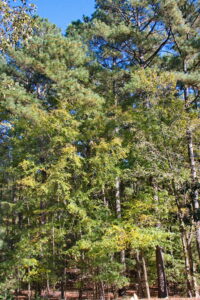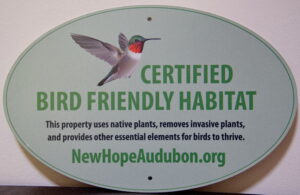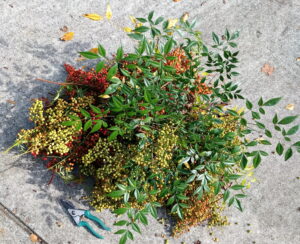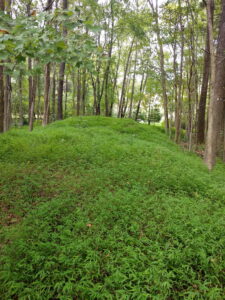Carol Woods–A Beautiful Green Island
Author: Norm Budnitz
[A version of this article first appeared in the Carol Woods News.]
In many communities, housing developments spring up and are named after trees that used to be there—Hickory Hills, The Oaks, Dogwood Acres. Those trees dominated the landscape, but they were removed to make way for the houses. Not so in the Carol Woods Retirement Community. The founders of our community wisely left many of the trees to shade the houses they built. And, even more wisely, they left extensive tracts of forest untouched by the construction crews. Our woods include dogwoods, redbuds, beeches, pines, tulip poplars, and multiple species of oaks and hickories. Perhaps half of our 120 acres is covered by this wonderful diversity of trees and the other plants associated with them, growing in the understory. The result is our ‘beautiful green island’ in the middle of extensive residential and commercial development on our side of Chapel Hill, North Carolina.
 An example of the maturing forest at Carol Woods with
An example of the maturing forest at Carol Woods withmixed pines and deciduous trees (photograph by Norm Budnitz)
A small group of residents, led by Susan Barco, contacted the local New Hope Audubon Society (NHAS) to have them visit our campus and help us assess its biological health and diversity. The NHAS Bird Friendly Certification Committee was established to aid homeowners in setting up their yards as small but significant habitats for birds. One yard might not make much of a difference, but 25 yards in a neighborhood becomes the equivalent of a small parkland. NHAS has recently expanded their program to reach out to small communities like ours and even to commercial developments who want to be good environmental stewards of their property.
After two trips to Carol Woods, the NHAS site visitors carefully analyzed the information they had gathered from seeing our residential areas, open spaces, and of course our forested areas. The result: they awarded us their highest rating, a platinum certification! From their experienced point of view (they have done more than 100 assessments), they felt that we have more than just a beautiful place to live. They were particularly impressed with “the quality of natural areas and canopy trees.” And they noted several other features that promote wildlife: our larger ponds and retention ponds, our bird and bat houses, our leaving dead snags and nurse logs in safe places when trees die, our minimal use of non-organic fertilizers, our gardens that attract pollinator insects, and more.
 The platinum certification plaque awarded to Carol Woods
The platinum certification plaque awarded to Carol Woodsfrom the New Hope Audubon Society (photograph by Norm Budnitz)
In short, we are providing a diverse environment that supports the health of many species of organisms from bacteria and fungi in the soil, through plants and worms and insects, and even amphibians, reptiles, birds, and mammals. (Side note: since moving into Carol Woods in late February 2021, I have already seen 50 species of birds.) We are, indeed, living in a diverse and ‘beautiful green island.’
But (you knew there would be a ‘but,’ didn’t you?), there are things we can do to maintain all this splendor. Tommy Best and his grounds crew have been doing amazing things along these lines. For example, last year and by the end of this transplanting season, they will have planted some 1,270 native tree seedlings. As our woodlands age, trees will die. Tommy is seeing to it that there will be a new generation to replace them. In our open meadow areas, the crew have seeded flowers that are both beautiful and provide protection from soil erosion. They are removing some of the invasive species like a patch of bamboo on the southeast side of the campus. And when weeds and other pests begin to create problems, they only use herbicides and insecticides very carefully and very locally. Kudos to Tommy and the grounds crew for maintaining our ‘beautiful green island.’
As you wander around campus and peer into the woods from sidewalks or trails, you may notice some plants that are growing in the understory below the trees. Some of these are young native trees that will grow up to replace their elders. Some are native plants and shrubs that help to maintain healthy soils, recycle important nutrients, and provide habitats for all those beneficial insects, salamanders, and very cool mushrooms. But if you look carefully, you may also see some invaders—plants that do not belong in a healthy woodlot. These ‘invasives’ are plants that we have introduced around our houses for their foliage, pretty flowers, or bright berries. Unfortunately, being non-native, they do not support the wildlife that will keep our forests diverse and healthy.
For example, whereas an oak tree may support hundreds of different species of caterpillars (yes, hundreds), a Bradford pear or a privet, may only support ten or even fewer. In the breeding season, birds need all those insects—so full of proteins and fats—to stuff down the gaping mouths of their chicks. Instead, non-native trees only provide carbohydrates (sugars) in their fruits. The birds do eat them, get the quick energy from those sugars, but none of the valuable proteins and fats they need. And later, the seeds from those fruits pass through the birds and get deposited elsewhere in the forest, spreading these invasive trees and shrubs and undermining the long-term health of the forest.
There are a number of these invasive species, but here’s a particularly insidious example of this problem. Nandina is a landscaping plant that has been planted all over Carol Woods. People love it for its evergreen foliage and its bright red berries that last through the drab winter months. Unfortunately, nandina has a particularly nasty habit of making and storing hydrogen cyanide in those pretty berries. Yes, cyanide, that chemical that the evil spies in the movies use to commit suicide when they are caught.
 Nandina berries collected in just a few minutes
Nandina berries collected in just a few minuteson the Carol Woods campus (photograph by Bob Fletcher)
In winter, many birds switch over from eating insects and seeds to eating fruit. Many wild winter fruits (dogwood, holly, and spicebush berries, for example) are bright red to attract birds. When the birds eat them, they digest the sugars and then pass the hard seeds through their guts and deposit them with a little package of fertilizer later. This is a great way for the parent plants to spread their offspring. Unfortunately, birds eat nandina berries, too, and spread them. If you walk through our woods, you can find nandina plants coming up everywhere. They are, indeed, invasive, and potentially dangerous.
 This carpet of the invasive Japanese stilt-grass chokes out
This carpet of the invasive Japanese stilt-grass chokes outthe native ground vegetation. (photograph by Bob Fletcher)
At Carol Woods, the residents have a Landscaping and Grounds Advisory Committee whose role is to advise and aid the grounds department here on campus. With their limited work force and resources, the grounds crew already have more than they can handle. So our committee has organized resident volunteers to monitor our woodlands and control nandinas and some of the other bad actors—privet, Elaeagnus species, mahonia, English ivy, and Japanese stilt-grass (aka Microstegium). We have already had two workdays and will schedule more in the ensuing months. Controlling these invasives is a long-term project, but anything we do will help to preserve our woods and keep our community a ‘beautiful green island.’
« Back to All Press